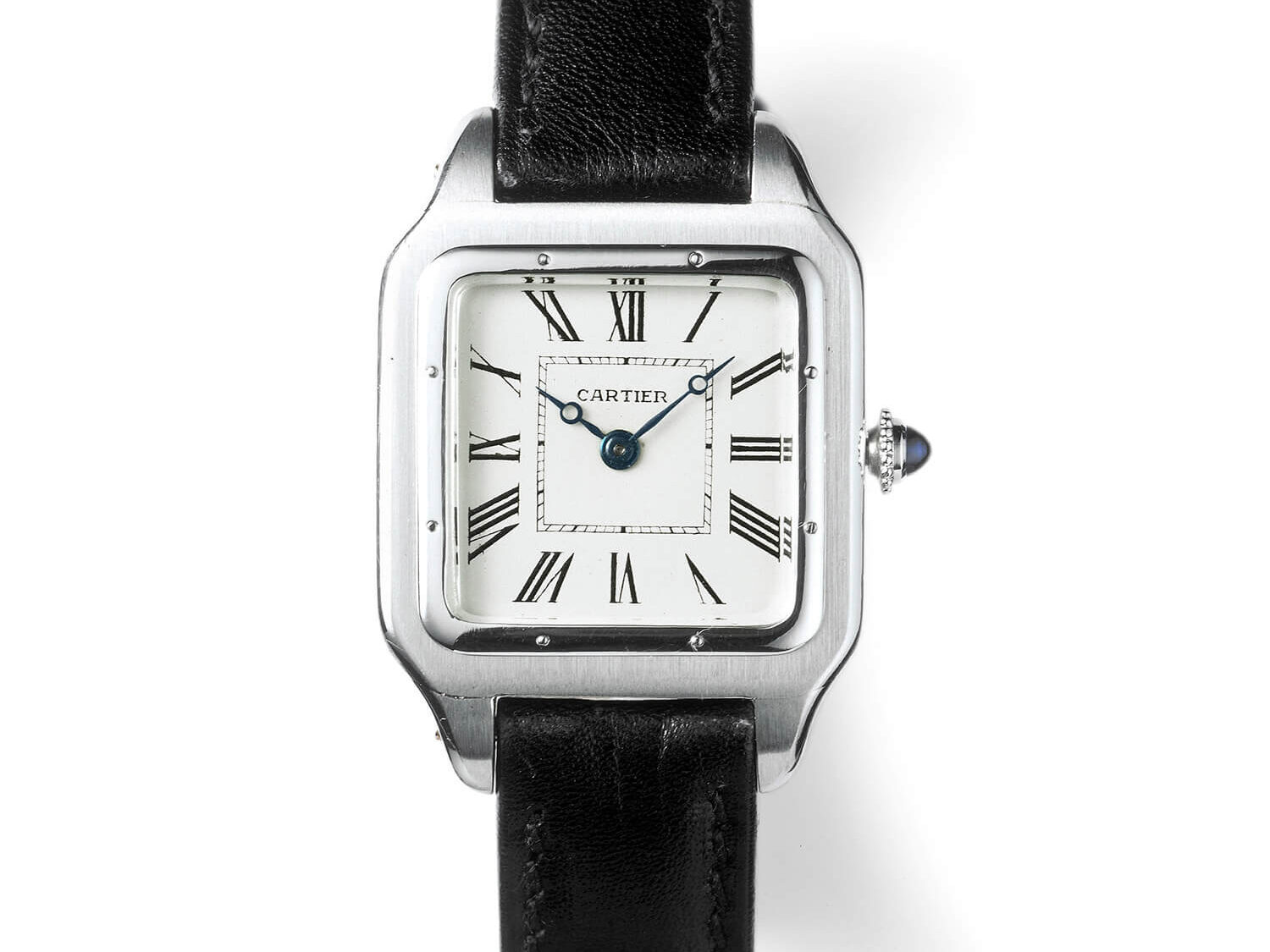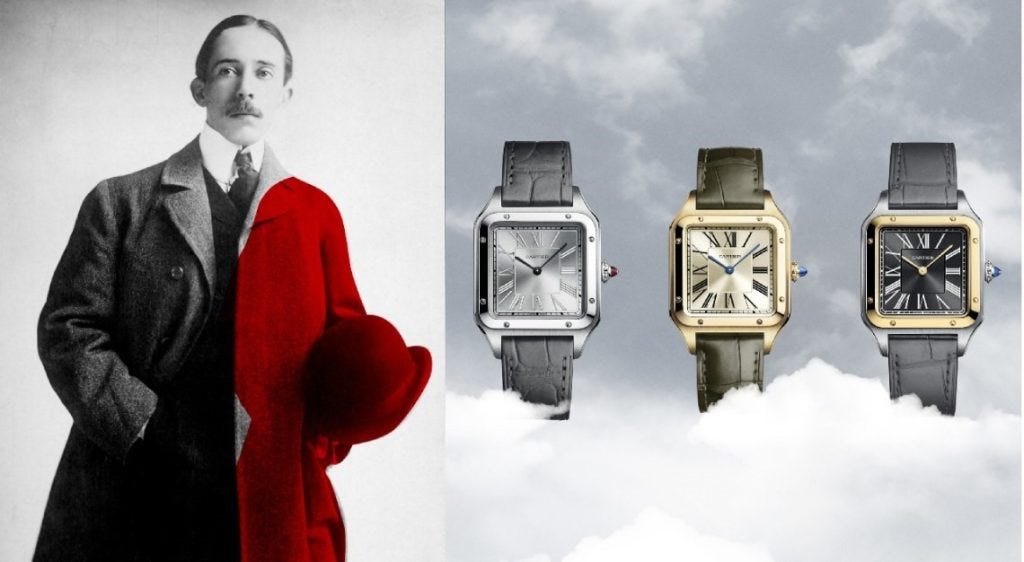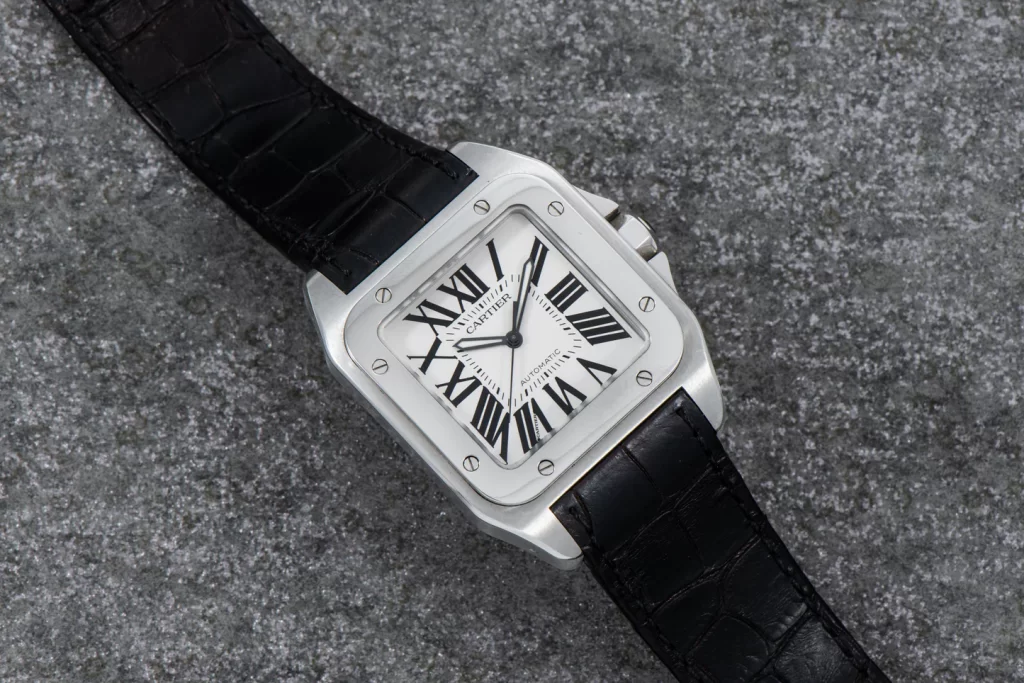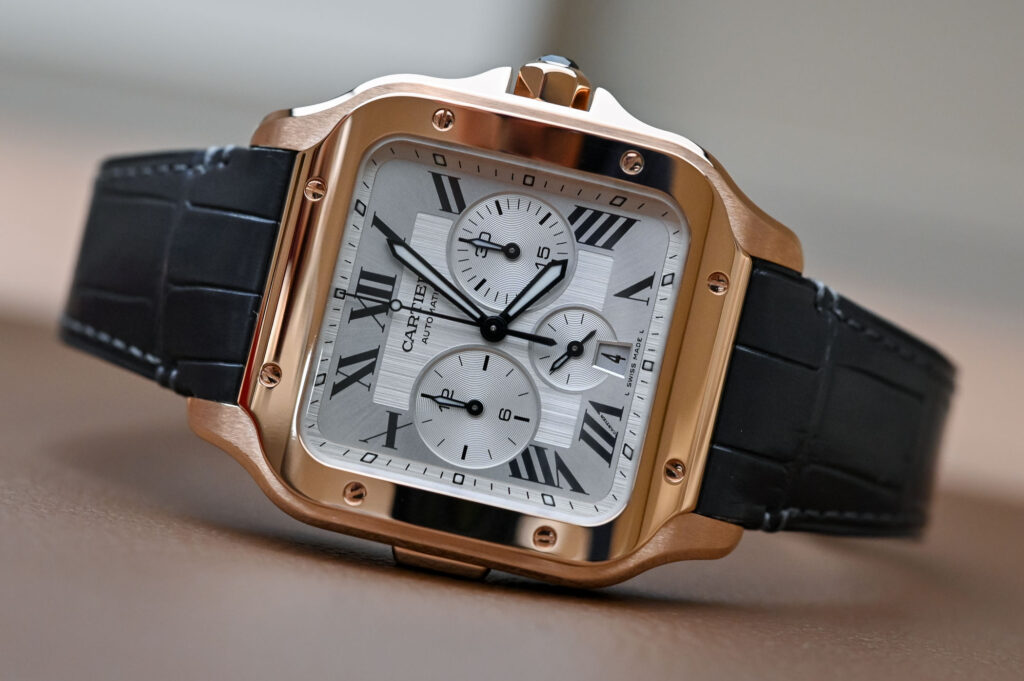Unveiling Cartier Santos History: Origins and Evolution

Key Highlights
- The Cartier Santos is renowned as the first’s wristwatch, making it a significant milestone in horological history.
- Its design language combines a square case with a signature square bezel, visible screws, and Roman numeral hour markers.
- The Santos is available in various materials, including yellow gold and stainless steel, offering a range of luxurious options.
- The use of Roman numerals adds a touch of elegance and sophistication to the dial the Santos.
- The Santos’ stainless steel case provides durability and a modern aesthetic, while yellow gold adds a touch of luxury.
- The combination of the square case and Roman numeral hour markers gives the Santos a timeless and classic appeal.
Introduction

The Cartier Santos holds a significant place in the world of watches as it is considered the first men’s wristwatch. Introduced in 1911, the Santos revolutionized the way people wore timepieces. While other watch brands may have notable technological innovations, Cartier takes pride in being the pioneer of the modern wristwatch. With its iconic design and exceptional craftsmanship, the Santos has become a symbol of luxury and elegance in the last century.
The Santos is known for its square case, signature square bezel with visible screws, and Roman numeral hour markers. Its design language exudes a classic and timeless aesthetic that has stood the test of time. The Santos is available in various materials, including yellow gold and stainless steel, catering to different preferences and styles. The watch also comes with the option of a metal bracelet or a leather strap, adding to its versatility and appeal.
Over the years, the Santos has evolved and adapted to the changing trends and advancements in watchmaking. From its original design to the latest models, the Santos continues to captivate watch enthusiasts with its distinctive style and innovative features. Let’s dive into the fascinating history of the Cartier Santos and explore its evolution over time, including the introduction of the Large model Santos with its ultra-thin design and convenient strap and bracelet system.
The Birth of an Icon: Louis Cartier and Alberto Santos-Dumont

The story of the Cartier Santos begins with a conversation between Louis Cartier, the renowned jeweler, and Alberto Santos-Dumont, a pioneering aviator. In the early 1900s, Santos-Dumont faced a challenge – checking time in-flight with traditional pocket watches was cumbersome. In 1904, he approached Louis Cartier with a unique request for a pilot-friendly watch. Moved by Santos-Dumont’s concerns, Cartier set out to create a wristwatch that would meet his needs.
In 1906, Cartier presented Santos-Dumont with a flat wristwatch featuring a square bezel. The watch proved to be a game-changer, allowing Santos-Dumont to easily check the time while in flight. This marked the birth of the Santos de Cartier, the world’s first mass-produced men’s wristwatch during the early 20th century and the advent of World War II. The collaboration between Louis Cartier and Alberto Santos-Dumont solidified the Santos as an iconic timepiece and laid the foundation for Cartier’s legacy in watchmaking.
The Historical Flight That Inspired the Cartier Santos history Watch

The inspiration behind the creation of the Santos watch can be traced back to a historical flight by Alberto Santos-Dumont. In 1906, Santos-Dumont took flight in an airplane for a duration of 21.5 seconds, becoming the first person to be filmed in an airplane flight. Throughout the flight, Santos-Dumont had a Cartier wristwatch on his wrist, showcasing the practicality and reliability of the wrist-worn timepiece.
This flight, which took place in the early 20th century, highlighted the need for a watch that could be easily accessed and read while in motion. Santos-Dumont’s flight, coupled with his feedback to Louis Cartier, led to the creation of the Santos watch. With its square case and legible dial design inspired by the radial layout of Paris’ streets and wide boulevards, the Santos became the first modern wristwatch and set the stage for the evolution of timekeeping technology.
The Design Revolution: From Pocket to Wrist
Before the introduction of the Santos, pocket watches were the no
rm, with men typically carrying them in their pockets. However, the Santos changed the game by shifting the focus to wrist-worn timepieces. The Santos’ square case design and leather strap were a departure from the traditional pocket watch, creating a new trend in timekeeping.
The Santos’ design revolutionized the way people wore watches, allowing for easy and convenient time-checking on the wrist. The leather strap provided a comfortable fit and added a touch of style to the timepiece. The Santos’ design language set a new standard in watch design, paving the way for future innovations and shaping the modern wristwatch as we know it today.
Milestones in the Santos Legacy

The Santos legacy is marked by several milestones that have shaped its evolution over the years. The original Santos watch, introduced in 1911, featured a yellow gold case and set the foundation for the iconic design language that defines the Santos collection.
Throughout its history, Cartier has released limited edition models of the Santos, showcasing the brand’s commitment to innovation and exclusivity. These limited edition timepieces feature unique designs and materials, catering to collectors and enthusiasts who appreciate the rarity and craftsmanship of these special editions. The milestones in the Santos legacy reflect Cartier’s dedication to pushing boundaries and cementing its status as a leader in the world of luxury watches.
The 1904 Original: Engineering and Aesthetics
The 1904 original Santos watch remains an engineering and aesthetic marvel. Its square case, inspired by a square pocket watch, sets it apart from traditional round watches. The Santos’ gold case adds a touch of luxury and elegance to its design.
The classic design of the Santos showcases Cartier’s attention to detail and commitment to craftsmanship. The square case, signature square bezel with visible screws, and Roman numeral hour markers create a timeless and sophisticated look. The Santos’ design language pays homage to the Art Deco era, with its clean lines and minimalist dial. The original Santos watch set the foundation for the iconic design that continues to define the Santos collection to this day, with its blackened Roman numerals nodding to the radial layout of Paris’ streets and wide boulevards.
The 1970s Revival: Adapting to the Quartz Crisis
In the 1970s, the watch industry faced a crisis with the rise of quartz movements. Cartier responded to this challenge by adapting the Santos to incorporate a quartz movement, ensuring accurate timekeeping and meeting the demands of the market.
The revival of the Santos in the 1970s introduced a stainless steel case and an integrated bracelet, creating a sportier and more contemporary look. This new Santos appealed to a younger audience and embraced the trend of luxury sports watches made in stainless steel with gold accents. The introduction of the stainless steel Santos with gold accents marked a departure from Cartier’s traditional use of precious metals and demonstrated the brand’s ability to adapt to changing times while maintaining its commitment to quality and design.
The Evolution of Style and Mechanism
The Santos has continuously evolved in terms of style and mechanism to meet the demands of modern watch enthusiasts. The Santos 100, introduced in 2004, features a larger case size and a more robust design. It retains the signature square case, Roman numeral hour markers, and visible screws that have become synonymous with the Santos collection.
The evolution of the Santos also includes the introduction of new materials, such as rose gold, and the incorporation of innovative features. The Santos 100 exemplifies Cartier’s ability to blend timeless design with modern aesthetics, appealing to both traditional watch enthusiasts and those with a penchant for contemporary style.
Santos Galbée: A Modern Interpretation

The Santos Galbée is a modern interpretation of the Santos watch, characterized by its clean lines and elegant aesthetic. This variation of the Santos features a curved case design that fits comfortably on the wrist and adds a touch of femininity to the collection.
The Santos Galbée is available in various materials, including rose gold, which adds a warm and luxurious tone to the timepiece. Its sleek and refined design makes it a versatile choice for both formal and casual occasions. The Santos Galbée embodies the essence of the Santos collection, combining classic design elements with modern sophistication.
The Introduction of the Santos 100 Series

The Santos 100 series was introduced in 2004 to commemorate the 100-year anniversary of the Santos watch. This series features a larger model with a steel case, catering to those who prefer a bolder and more substantial timepiece.
The Santos 100 retains the iconic design elements of the Santos collection, including the square case, Roman numeral hour markers, and visible screws. Its larger size and stainless steel construction give it a sportier and more modern look. The Santos 100 is a testament to Cartier’s ability to adapt and innovate while staying true to its heritage and design language, with the introduction of the Santos Demoiselle series aimed towards women. These models feature smaller case sizes, quartz movements, and come in steel, yellow gold, and white gold, providing a new option for those looking for a feminine touch in their Santos watch.
The Santos Collection Today

The Santos collection continues to evolve and captivate watch enthusiasts with its latest models. The new Santos de Cartier, launched in 2018, features a range of new timepieces that showcase Cartier’s mastery in watchmaking.
The collection includes the Santos Chronograph, which combines the iconic design of the Santos with a chronograph complication, adding more functionality to the timepiece. The Santos collection also offers a variety of models in precious metals such as yellow gold and rose gold, showcasing Cartier’s mastery of luxury materials. The Santos collection today represents the culmination of Cartier’s rich heritage and ongoing commitment to innovation and style.
2018 Rebirth: Innovations and New Models
In 2018, Cartier breathed new life into the Santos collection with the launch of the Santos in 13 new models. These new models showcased Cartier’s mastery in watchmaking and brought innovative features to the forefront.
One of the notable innovations introduced in 2018 was the integrated bracelet, which allowed for seamless and easy wearability. This innovation exemplifies Cartier’s commitment to both style and functionality. The new models also featured a range of materials, including stainless steel, yellow gold, and rose gold, catering to different preferences and styles. The 2018 rebirth of the Santos collection showcased Cartier’s ability to push boundaries and redefine the modern wristwatch.
The 2019 Expansion: Santos Chronograph and More

In 2019, Cartier expanded the Santos collection even further with the introduction of the Santos Chronograph and a new quartz-powered Santos-Dumont. The Santos Chronograph added a new level of functionality to the collection with its stopwatch capabilities.
The Santos Chronograph is available in a variety of materials and dial options, including grey and blue dials, offering versatility and personalization. These new additions to the Santos collection cater to the preferences of both connoisseurs and those new to the world of luxury watches. The 2019 expansion of the Santos collection solidified its place as a modern and innovative line of timepieces, including the stunning two-tone steel-and-gold model with a grey dial.
Cultural Impact and Iconic Moments
The Santos watch has made a significant cultural impact and has been spotted on the wrists of numerous celebrities over the years. Its timeless design and association with luxury have made it a favorite among the rich and famous.
The Santos watch has been featured in pop culture and has become synonymous with style and sophistication. It has appeared in movies and has been worn by celebrities such as Tom Cruise and Tom Holland. The Santos watch’s cultural significance and iconic status contribute to its enduring popularity and desirability.
Celebrities and the Cartier Santos

Celebrities have long been enamored with the Cartier Santos watch. Notable figures, from actors to musicians, have showcased this iconic timepiece on red carpets and in everyday life, adding a touch of luxury to their outfits. The Santos’ blend of history, style, and craftsmanship has made it a favorite among the fashion-forward elite. Its presence on the wrists of celebrities further solidifies its status as a timeless accessory that transcends trends.
The Santos in Pop Culture and Cinema
The Cartier Santos has made its mark in popular culture and cinema. It is closely associated with the Brazilian aviator Alberto Santos-Dumont, who was a prominent figure in the early days of aviation. Santos-Dumont’s preference for the Santos watch during his flights helped popularize it among other aviators and the general public.
The design of the Santos, with its clean lines and Art Deco influences, has made it a classic timepiece that transcends trends. It has been featured in various films, adding to its allure and iconic status. The Santos has been worn by characters in movies like “Top Gun” and “Spider-Man,” further cementing its association with adventure and style. Its presence in pop culture and cinema has contributed to the continued popularity of the Santos watch.
Technical Mastery: Materials and Craftsmanship
The Cartier Santos exemplifies the technical mastery and craftsmanship that Cartier is known for. Each watch is meticulously crafted in Cartier’s workshop in Paris, ensuring the highest level of quality and attention to detail.
The use of Roman numerals on the dial is a nod to Cartier’s traditional design aesthetic, adding a touch of elegance and sophistication. The steel bezel not only provides a sleek and modern look but also enhances the durability of the watch. Cartier’s commitment to using the finest materials and employing skilled artisans is evident in every Santos timepiece.
Exploring the Range of Materials Used
The Cartier Santos offers a range of materials to suit different preferences and styles. From stainless steel to yellow gold and rose gold, each material brings its own unique character to the watch.
Stainless steel is a popular choice for its durability and versatility. It offers a sleek and modern look that can be dressed up or down for any occasion. Yellow gold, on the other hand, adds a touch of luxury and sophistication. It has a timeless appeal that exudes elegance.
For those looking for a more subtle and romantic aesthetic, rose gold is an excellent option. Its warm hue adds a soft and feminine touch to the watch. Cartier’s use of these materials ensures that there is a Santos watch for every individual’s taste and style.
Text Table: Range of Materials Used in the Cartier Santos
| Material | Description |
| Stainless steel | Durable and versatile, offers a modern look |
| Yellow gold | Adds a touch of luxury and sophistication |
| Rose gold | Subtle and romantic aesthetic, adds a soft and feminine touch to the watch |
The Art of Watchmaking: Movements and Complications
The Cartier Santos is not only a stylish timepiece but also a marvel of watchmaking. It showcases the expertise and precision that goes into creating a high-quality watch.
The movement, or the mechanism inside the watch, is a crucial component that determines its accuracy and functionality. Cartier ensures that each Santos watch is equipped with a reliable and precise movement, ensuring accurate timekeeping.
In addition to the standard timekeeping function, some Santos models also feature complications. These are additional features or functions that enhance the watch’s usefulness. Complications can include chronographs, moon phase displays, or even tourbillons. These complications showcase Cartier’s commitment to pushing the boundaries of watchmaking and offering innovative features in their timepieces.
The Santos Beyond Timekeeping
The Cartier Santos goes beyond its primary function as a timekeeping device. It has become a symbol of status and luxury, coveted by discerning individuals around the world.
The Santos is not just a watch; it is a statement piece that reflects the wearer’s taste and style. Its iconic design and association with Cartier’s heritage make it a sought-after collector’s item.
Owning a Cartier Santos is a testament to one’s appreciation for fine craftsmanship and timeless elegance. It is a watch that transcends trends and stands the test of time, making it a valuable addition to any watch collection.
A Symbol of Status and Innovation
The Cartier Santos has long been regarded as a symbol of status and innovation. Its association with prominent figures like Alberto Santos-Dumont and its presence in popular culture have solidified its status as a coveted timepiece.
The Santos represents more than just a watch; it embodies the spirit of innovation that Cartier is known for. From its pioneering design as the first wristwatch to its continuous evolution over the years, the Santos showcases Cartier’s commitment to pushing the boundaries of watchmaking.
Owning a Cartier Santos is a statement of sophistication and style. It is a testament to the wearer’s appreciation for fine craftsmanship and their desire to own a piece of horological history.
The Watch as a Collector’s Piece
The Cartier Santos is not only a timepiece but also a collector’s piece that holds significant value in the watch market. Its iconic design, historical importance, and limited editions make it highly sought after by collectors.
Limited edition versions of the Santos, featuring unique materials or special features, are particularly desirable among collectors. These rare pieces often command a premium price and become highly sought after in the secondary market.
The use of precious metals like gold and platinum further adds to the collectability of the Santos. These materials not only enhance the aesthetic appeal of the watch but also increase its intrinsic value.
For watch collectors, owning a Cartier Santos is a way to appreciate the artistry and craftsmanship that goes into creating a timepiece. It is a piece of horological history that holds both sentimental and monetary value.
Conclusion
In conclusion, the Cartier Santos watch stands as a timeless symbol of innovation and style, transcending generations with its rich history and iconic design. From its aviation-inspired origins to its modern interpretations, the Santos collection continues to captivate watch enthusiasts worldwide. With a legacy steeped in craftsmanship and cultural significance, the Santos remains a coveted piece that represents status and elegance. Whether worn by celebrities or featured in cinema, the Santos watch is not just a timepiece but a statement of artistry and technical mastery. Delve into the world of Cartier Santos and discover the allure of a watch that goes beyond mere timekeeping.
Frequently Asked Questions
What Makes the Cartier Santos Iconic?
The Cartier Santos is iconic for its design and historical significance. It was the first wristwatch and became popularized by pioneering aviator Alberto Santos-Dumont. Its design, created by Louis Cartier, has become synonymous with elegance and sophistication.
https://www.cartier.com/en-us/home
https://www.cartier.com/en-us/watches/collections/santos-de-cartier
https://www.the1916company.com
https://www.cartier.mx/relojes/cartier/santos%20de%20cartier
https://www.rescapement.com/blog/cartier-santos-a-brief-history
https://www.gq.com/sponsored/story/the-high-flying-origin-story-of-the-santos-de-cartier-watch

Leave a Reply